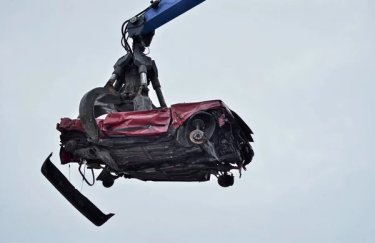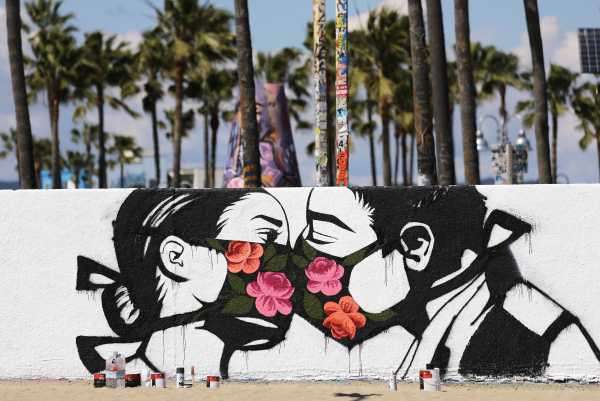
This story is part of a group of stories called

Finding the best ways to do good.
A few months ago, California looked like a success story in the face of the coronavirus pandemic. As New York state’s coronavirus outbreak reached its peak, California’s Covid-19 death rate was less than a tenth of New York’s.
Now, California’s Covid-19 outbreak has gotten so bad that the state is partly closing back down — with Gov. Gavin Newsom on Monday announcing that the state will halt indoor operations for restaurants, wineries, and movie theaters, among other venues, and close bars entirely. It’s an aggressive expansion of a previous action to shut down these kinds of operations in select counties.
California had taken a turn for the worse in recent weeks. Its daily new coronavirus cases are up more than double compared to the previous month. The test positivity rate — an indicator of how widespread infection is, as well as whether an area is conducting enough testing — is increasing, too. Hospitalizations are also up, as hospitals in Los Angeles and other areas have warned they could reach capacity soon. And deaths have started to climb in the state.
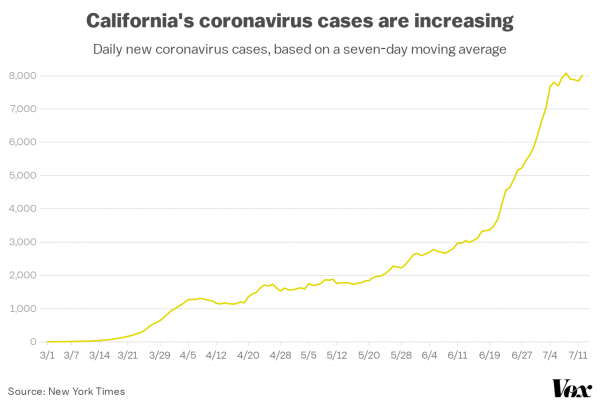
So what happened?
The short of it, experts say, is that much of California let its guard down. While the state, and the Bay Area in particular, was among the first in the US to embrace a shelter-at-home order, parts of California have since relaxed or outright halted those measures, letting the coronavirus creep in bit by bit. Meanwhile, precautions against Covid-19 have been inconsistently adopted by the public and businesses — especially as some of the recommended practices, such as wearing a mask, have become politicized.
At the same time, the state has seen major outbreaks in nursing homes, in prisons, and among migrant workers — many of whom are deemed “essential” and are therefore forced to work — that have driven up coronavirus cases further, simultaneously planting seeds for broader community outbreaks.
It’s this mix — of relaxed social distancing policies, inconsistent adoption of precautions, and rise of new Covid-19 hot spots — that have led to California’s turn for the worse. That combination seems to have hit some demographics particularly hard: Cases are especially rising among younger groups — who are perhaps more likely to take advantage of, say, bars reopening — and in Latin communities, where people are more likely to work for businesses deemed “essential,” such as grocery stores or farms.
“The story of California is the story of why we all have to do more,” Kirsten Bibbins-Domingo, an epidemiologist at the University of California San Francisco, told me. “I don’t think we can easily point to a totally outrageous government policy or a totally outrageous citizen action or a totally outrageous anything. It really is that all of these things together matter.” As the state reopened, she argued, “We actually should have upped our game at that time, not just be complacent that we had done so well while we were sheltered.”
Some of the overall uptick in cases is likely due to more testing. All else held equal, more testing will catch more cases. But testing isn’t the whole story; it can’t explain why, for one, hospitalizations and deaths linked to Covid-19 have risen as well.
The outbreaks aren’t universal. The southern parts of the state, including Los Angeles and Imperial County, have been hit much harder compared with some northern areas, including San Francisco and the broader Bay Area.
“We’re a large and diverse state,” Bibbins-Domingo said. “The variations in how different counties have experienced the epidemic and have adopted important public health measures, like masking, have not been helpful.”
The overall trend in California isn’t as bad as the massive outbreaks currently happening in Arizona, Florida, and Texas. That’s likely a result of the state’s slower reopening. People in a predominantly Democratic state are also more likely to embrace changes that President Donald Trump railed against, like when he suggested that people wear masks to spite him.
Still, the trends are heading in the wrong direction in much of California — complicating the image of a state once praised for its quick, decisive action against Covid-19 outbreaks, and underscoring that even states performing well need to maintain vigilance against the virus.
Reopening, predictably, led to more coronavirus cases
On March 16, the Bay Area issued the country’s first regional shelter-in-place order. California followed three days later with a statewide order. It’s this lead of several days, compared with other states, that experts said helped California stay largely ahead of the outbreak, at least at first: When cases can double in a span of 24 to 72 hours, taking action even a few days early can play a huge role.
The research suggests the lockdowns worked. One study in Health Affairs concluded:
Over time, though, state leaders came under pressure by businesses and workers to open up again and end the economic pain. As Covid-19 cases remained relatively flat (although they never truly decreased on a statewide level), there was also a growing sentiment that the situation in California was under control. Some towns, cities, and counties argued that they never suffered a big coronavirus outbreak, so they shouldn’t have to follow the state’s strict rules.
Under all this pressure, Newsom started to relax social distancing measures in May — with a plan to open the state in phases — and delegated more decision-making for reopening down to the local level. While some places, including the Bay Area, have kept a tighter leash than others, the trend in much of the state was toward relaxed restrictions, with workplaces, restaurants, bars, and other venues opening up again.
“Our original response was right on. The politicians really stuck their necks out on it. And I think it’s paid off, with thousands of lives saved,” George Rutherford, an epidemiologist at UCSF, told me. However, “there’s a playbook for what to do, but not a playbook for how to undo it. So I think we’re kind of all feeling our ways.”
The public seemed to embrace the reopening. While restaurant data from OpenTable indicates that dine-in seating in California was down by 90 to 100 percent for most of May, for much of June it was down by 60 to 70 percent — still a huge hit to restaurants, but not nearly as much of one.
The result is that people are increasingly out and about, interacting and infecting each other with the coronavirus. Friends and families began gathering again, especially as they celebrated Memorial Day and the summer kicked off. And as they came together — in poorly ventilated homes, restaurants, and bars, in close proximity to people they don’t live with, often for hours at a time — people spread the virus much more frequently.
Some experts questioned bars and other high-risk indoor spaces reopening in the first place. “From a pandemic standpoint, there’s probably not anything good happening in a bar,” Bibbins-Domingo said. She argued for better priorities in reopening: “We shouldn’t have overreacted to some of the beaches and going outside, and we probably should have been much clearer on the bars.”
Changes in policy can’t fully explain every single outbreak. Some people would break the rules anyway, and others, such as migrant agricultural workers deemed “essential,” were largely exempted from the start. There are factors outside the control of these policies, such as overcrowded housing and tech workers in the Bay Area being able to work from home to social distance while farmers in southern parts of the state can’t.
The outbreaks in some settings, such as nursing homes and prisons, also aren’t as directly tied to reopenings. Prisons are largely cut off from the community, and visitation in nursing homes has been heavily curtailed by the pandemic. The outbreak at a prison in Northern California, San Quentin, seemed to be the result of the transfer of inmates from another prison where infections were rising.
But social distancing restrictions likely played some role even in these examples, given that the virus had to get into these facilities somehow. Nursing home employees, prison guards, and migrant workers, after all, go home and perhaps to bars or restaurants at the end of the workday. In the end, greater community transmission affects everyone in a community.
Local and state officials have also pinned some of the blame on Black Lives Matter protests. But the research and data so far suggest the demonstrations didn’t lead to a significant increase in Covid-19 cases, thanks to protests mostly taking place outside and participants embracing steps, such as wearing masks, that mitigate the risk of transmission.
The decline of social distancing and the rise in cases also aligns with what researchers have seen in past disease outbreaks. Several studies of the 1918 flu pandemic found that quicker and more aggressive steps to enforce social distancing saved lives in those areas. But this research also shows the consequences of pulling back restrictions too early: A 2007 study in JAMA found that when St. Louis — widely praised for its response to the 1918 pandemic — eased its school closures, bans on public gatherings, and other restrictions, it saw a rise in deaths.
Here’s how that looks in chart form, with the dotted line representing excess flu deaths and the black and gray bars showing when social distancing measures were in place. The peak came after those measures were lifted, and the death rate fell only after they were reinstated.
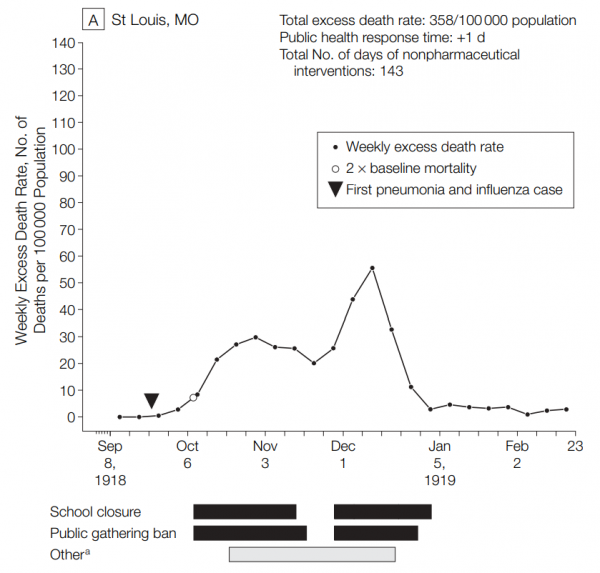
This did not just happen in St. Louis. Analyzing data from 43 cities, the JAMA study found this pattern repeatedly across the country. Howard Markel, a co-author of the study and the director of the University of Michigan’s Center for the History of Medicine, described the results as a bunch of “double-humped epi curves” — officials instituted social distancing measures, saw flu cases fall, then pulled back the measures and saw flu cases rise again.
California has seen that in real time: Social distancing worked at first. But as it’s relaxed social distancing, it’s seen cases quickly rise.
Some people aren’t wearing masks or taking other precautions
As California reopened, experts said the spread of Covid-19 was compounded by some people who failed or refused to follow recommended precautions against the virus.
There was particular resistance to wearing masks in more conservative areas of California, especially in the southern parts of the state. Orange County’s chief health officer resigned due to public resistance against a mask-wearing order. Sheriffs in Orange, Riverside, Fresno, and Sacramento counties said they wouldn’t enforce Newsom’s June order requiring masks in public and high-risk areas. Anecdotally, experts and others in the state told me that mask-wearing seems to be more common in the Bay Area than in the southern parts of California.
The evidence increasingly supports the use of masks to combat Covid-19. Several recent studies found that masks alone reduce transmission. Some experts hypothesize — and early research suggests — that masks played a significant role in containing outbreaks in several Asian countries where their use is widespread, like South Korea and Japan.
The resistance to masks in California, as well as nationwide, is at least partially political. As recommendations and requirements for masks have increased, some conservatives have suggested wearing a mask is emblematic of an overreaction to the coronavirus pandemic that has eroded civil liberties. President Trump, for one, has by and large refused to wear a mask in public, even saying that people wear masks to spite him and suggesting, contrary to the evidence, that masks do more harm than good. While some Republicans are breaking from Trump on this issue, his comments and actions have helped politicize mask-wearing.
There’s also general fatigue, with people growing more and more tired of social distancing as the pandemic continues. Surveys from Gallup found that just 39 percent of people were “always” social distancing in late June, compared with 65 percent in early April; the number of people who “sometimes,” “rarely,” or “never” practice social distancing increased from 7 to 27 percent in the same time frame.
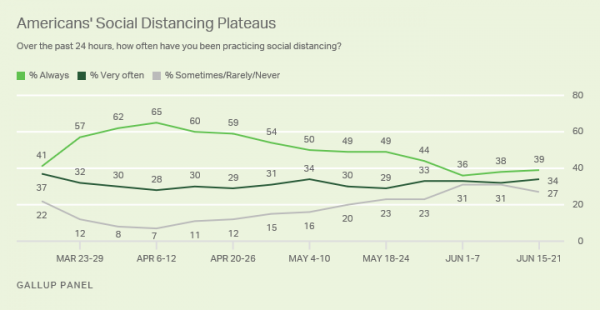
Some experts argue public outreach has failed with regard to encouraging social distancing and mask-wearing, arguing officials could do a much better job not only at communicating the right steps but also at persuading the public to adopt them. They could also do more to reach marginalized communities — in California, by tailoring messages and support to Latin workers in particular.
Nationwide, education is “where we really failed in this outbreak,” Krutika Kuppalli, an infectious disease specialist and a fellow in the Emerging Leaders in Biosecurity Initiative at the Johns Hopkins Center for Health Security, told me. Kuppalli pointed to masks as one example where there’s clearly more work to be done. “Shaming people is not going to make them wear masks,” she explained. “It’s about trying to get people to understand that it’s for the greater good of the community.”
Beyond that, enforcement of social distancing requirements hasn’t been consistent — a problem Newsom acknowledged when he said the state plans to step up enforcement.
The result of all of this is seen in not only the actions of individuals but also those of businesses. Los Angeles officials in late June found 33 percent of local restaurants and 49 percent of bars weren’t following social distancing protocols, and employees at 44 percent of restaurants and 54 percent of bars weren’t wearing masks or face shields, according to the Los Angeles Times.
The state has to pull back reopening now, before it gets much worse
California isn’t as bad as several other hot spots are in terms of coronavirus cases. Arizona and Florida have more than double the number of cases per day per person, and Texas has nearly 50 percent more.
But the goal, experts argue, is to start cracking down before things get as bad as Arizona or Florida. Because the lag between infection and the onset of symptoms can be as long as two weeks, officials are typically acting too late if they react only once more cases or hospitalizations get reported. In fact, that’s one reason California was initially praised several months ago: The state and Bay Area took the virus seriously before it became a problem on the scale of what New York was seeing at the time.
“One of the things I’ve learned in any outbreak is that if it seems you overreacted, you’ve done a good job,” Kuppalli said. What looks like overreaction, she added, means that “we prevented things from becoming a catastrophe. We don’t want to wait until things are a catastrophe and then react, because that’s too late.”
In some sense, then, Newsom’s latest moves are too late — as cases, hospitalizations, and deaths have already crept up for weeks.
Now it’s an open question if the state can avoid another stay-at-home order. If things were to get to a certain level — where hospitals reach capacity and the death toll is exponentially rising — a full lockdown could be the only option to get the outbreak under control again. To not get to that point, experts have called for more targeted measures, from aggressive testing, contact tracing, and isolating to closing down high-risk areas, particularly indoor venues that are often packed and poorly ventilated.
“We don’t want to get to the point where we just tell everyone to stay home if there are more targeted measures as a starting point,” Cyrus Shahpar, director at Resolve to Save Lives, told me.
So far, the more targeted approach is what Newsom is embracing — shutting down bars, movie theaters, and other indoor gatherings, and encouraging outdoor options for dining. Only in extreme cases, like with Imperial County, has the state pushed more drastic action.
Some of this responsibility falls on the public, too. When people go out, experts recommend wearing a mask, prioritizing outdoor venues over indoor spaces, keeping 6 feet from each other, not touching your face, and washing your hands. How well a community as a whole does that can dictate how bad things get.
“We have to be totally serious about masks,” Rutherford said. “No more screwing around.”
California may have already lost its reputation as being quick to act in the face of the coronavirus. But officials and experts are hoping it still has time to avoid becoming a huge epicenter for Covid-19 — as long as its leaders and the public react accordingly to the rise in cases and deaths.
Support Vox’s explanatory journalism
Every day at Vox, we aim to answer your most important questions and provide you, and our audience around the world, with information that has the power to save lives. Our mission has never been more vital than it is in this moment: to empower you through understanding. Vox’s work is reaching more people than ever, but our distinctive brand of explanatory journalism takes resources — particularly during a pandemic and an economic downturn. Your financial contribution will not constitute a donation, but it will enable our staff to continue to offer free articles, videos, and podcasts at the quality and volume that this moment requires. Please consider making a contribution to Vox today.
Sourse: vox.com

